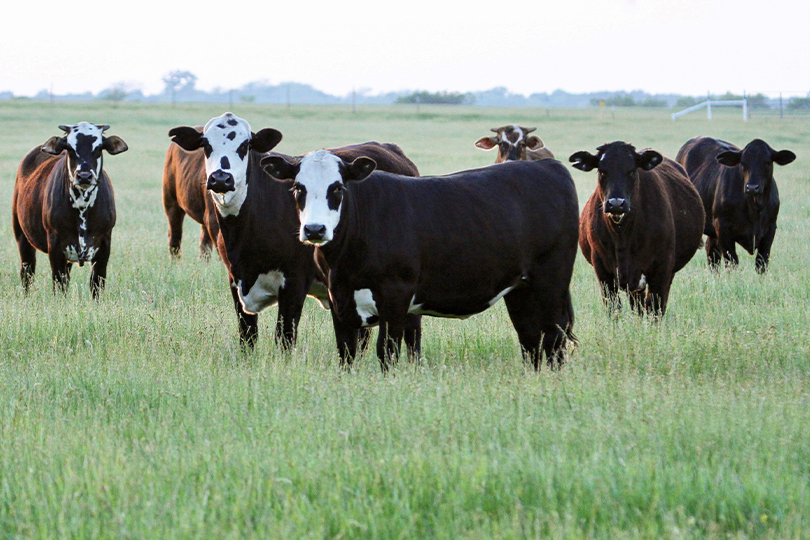Continued high prices and profitability are forecast for cattle producers as the industry enters the year with the smallest cattle inventory in 70 years.
Reduced cattle numbers and beef production are expected to continue over the next three years, CattleFax economists noted.
“Though drought conditions did improve in many regions, over a third of the cow herd was affected by drought in 2023, causing limited heifer retention and more liquidation in some regions,” Kevin Good, vice president of Market Analysis at CattleFax, said. “This will limit growth to the cow herd near-term.”
The peak in cattle prices, according to CattleFax, is forecast to occur in 2025-2026.
“In the meantime, industry profitability will continue to swing in favor of the cow-calf producer as excess feeding and packing capacity chases a declining supply of feeder cattle and calves,” according to CattleFax’s industry outlook.
Herd expansion
Heifer retention has not yet started on a nationwide level.
Heifers kept as beef cow replacements were estimated at 4.86 million head, down 1% from 2023. While the inventory of beef cattle is low, this is a small year-over-year decline in replacement heifers compared to the 6% drop in 2022. Economists say it may be an indicator that the contraction phase of the cattle cycle is beginning to slow.
Those producers who do start to grow their herds will face higher costs to retain or purchase heifers. Both cattle prices and financing interest rates are high.
Production
There are currently enough cattle in the supply chain for processing, which will help to stabilize prices in the short term.
However, American Farm Bureau Federation economists note that as the cattle on feed supply begins to shrink based on fewer calves, processors will have to compete for cattle, which could lead to higher costs, especially in the second half of 2024.
CattleFax predicts feeder cattle and calf supplies outside of feedyards will be 1 million head smaller than 2023 at 24.1 million head.
Commercial fed slaughter in 2024 is forecast to decline by 750,000 to 24.8 million head.
After about a 1.3-billion-pound decline in 2023, beef production is forecast down another billion pounds in 2024 to total about 25.9 billion pounds. The decline in production in 2024 will lead to a 1.7-pound decline in U.S. consumption of beef to 56 pounds per person.
Market forecast
The average 2024 fed steer price is forecast at $184/cwt, up $9/cwt from 2023.
All cattle classes are expected to trade higher and prices are expected to continue to trend upward.
The 800-pound steer price is expected to average $240/cwt, and the 550-pund steer is expected to average $290/cwt. On utility cows, the average will be $115/cwt, with bred cows average $2,600/cwt.
Demand
Demand is currently high for beef, but how much are consumers willing to pay? That’s a concern as record-high beef prices could be seen at grocery stores this year.
“When thinking about what demand looks like, we need to think about what our consumer looks like with the U.S. economy being the driving factor going into 2024,” Good said. “Though inflation has moderated, consumer debt and interest rates, cheaper alternative proteins and economic uncertainty may limit spending and impact purchasing decisions.”
On a global scale, demand for U.S. beef has remained relatively strong with South Korea, Japan, China and Taiwan. But difficult economic conditions combined with increased Australian beef production have put downward pressure on global demand for U.S. beef.
Weather
El Niño provided desperately needed moisture and improved drought conditions across Texas and much of the South and Southeast.
But El Niño is expected to fade away, and La Niña is showing signs of making a rapid return.
Historical data shows that La Niña, since 1998, has been more frequent, and each event lasts two to three years.
Increased heat and drought-related issues will become more prevalent for the Central to Southern Plains as La Niña’s influence grows.
Feed costs
Although 2023 brought wetter conditions and more hay was baled, hay supplies remain limited in Texas and other states.
“Another good hay crop needs to be seen in 2024 to help rebuild stocks from the lows in 2022 and return prices to a more historically normal range,” Troy Brockelmann, CattleFax director of Protein and Grain Analysis, said. “The first half of 2024 will likely see prices supported at more elevated levels before dropping by roughly $30/ton following harvest.”
A record corn crop in 2023 has also helped bring feed prices down.
In summary
The fundamental elements are in place to continue showing market leverage and profitability for cow-calf ranchers.
Increased cattle prices and reduced feeding costs will help improve margins for cow-calf producers for the next several years, a much-needed improvement to drive expansion as weather patterns allow.


Leave A Comment